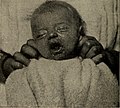Archivo:Diseases of children (1916) (14597432110).jpg

Tamaño de esta previsualización: 664 × 600 píxeles. Otras resoluciones: 266 × 240 píxeles · 531 × 480 píxeles · 850 × 768 píxeles · 1133 × 1024 píxeles · 1618 × 1462 píxeles.
Ver la imagen en su resolución original (1618 × 1462 píxeles; tamaño de archivo: 613 kB; tipo MIME: image/jpeg)
Historial del archivo
Haz clic sobre una fecha y hora para ver el archivo tal como apareció en ese momento.
| Fecha y hora | Miniatura | Dimensiones | Usuario | Comentario | |
|---|---|---|---|---|---|
| actual | 09:09 17 sep 2015 |  | 1618 × 1462 (613 kB) | Fæ | == {{int:filedesc}} == {{subst:chc}} {{information |description={{en|1=<br> '''Identifier''': diseasesofchi00mcco ([https://commons.wikimedia.org/w/index.php?title=Special%3ASearch&profile=default&fulltext=Search&search=insource%3A%2Fdiseasesofchi00mcc... |
Usos del archivo
La siguiente página usa este archivo:
Uso global del archivo
Las wikis siguientes utilizan este archivo:
- Uso en ar.wikipedia.org
- Uso en en.wikipedia.org